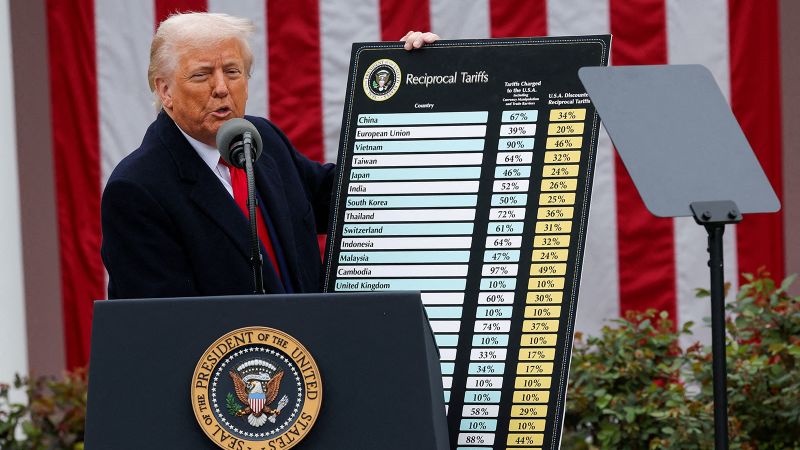
President Donald Trump’s auto tariffs, which went into effect at 12:01 am ET on Thursday, have the potential to upend a crucial American industry and raise the cost of tens of millions of cars sold every year across the country. Many products are likely to be subject to higher prices due to the tariffs. But none will cost Americans more, or shake as critical an industry as the tax on imported cars that just went into effect or the tariffs on auto parts that are due soon.
America’s economy has evolved over the past half a century – today, it is a service economy, not one built around manufacturing. The United States makes far fewer cars than it once did. But autos are still a key pillar of the US economy, responsible for driving growth and millions of jobs.

However, the long-established model of operation and economics of the industry are shaken by these new rules. Cars are crucial to American’s daily lives: getting to work, going shopping, traveling on vacation. Prices are already near record levels, with a new car costing nearly $50,000 on average.
That is likely to go higher in the weeks and months ahead, making it much more difficult for afford the cars they want or need. What just took place The Trump administration placed tariffs of 25% on all cars shipped to America from other countries. Those imports account for nearly half of the 16 million new cars purchased in the United States in 2024, according to S&P Global Mobility.
Mexico is the largest source of those imports, sending 2.5 million cars to US dealerships. Canada ships another 1.
1 million, while an additional 3.7 million come from countries outside North America including South Korea, Japan and Germany. To put in context, an imported car with a value of $40,000 would be hit with a $10,000 tax.
That is a cost someone along the supply chain will have to bear. “There is a healthy debate to be had over how that cost might be shared between the suppliers, the (automakers), dealers and the final consumers,” said an auto executive to CNN on background last week. The consumer “will see a fair chunk of it.
” The Trump administration is also expected to roll out tariffs on auto part imports no later than May 3. And when tariffs on car parts go into place, that means it will cost more to produce cars even at US auto plants. That’s because every domestic vehicle contains imported parts.
For decades, ever since the North American Free Trade Agreement or NAFTA went into effect in the early 1990s, the automakers have operated as if the United States, Mexico and Canada are a single country. Companies move parts across the border several times during the assembly process. Today, every one of 10.
2 million cars made at US factories have a significant amount of Mexican and Canadian parts – typically between 25% and 60%. Analysis by Bank of America says that tariffs on car parts will increase the cost of American made cars by about $4,000. Another analysis by Anderson Economic Group puts the cost at more than $12,000 for some vehicles.
“Let’s be real honest: Long term, a 25% tariff across the Mexico and Canada borders would blow a hole in the US industry that we’ve never seen,” said Ford CEO Jim Farley in comments to investors in February. What tariffs mean to car buyers Cars are the second largest purchase for most households, behind housing. Last year, American consumers purchased about 13 million new cars and 40 million used cars.
That means nearly 40% of US households bought a car in 2024. And those millions of Americans will soon face higher prices. Not just because of the increased cost of building a car, but because of the basic economic theory of supply and demand.
Virtually every car purchase is done through a negotiation between car dealer and buyer, which are greatly influenced by the availability of the car that the buyer wants to buy. Less supply translates to higher prices, and the tariffs mean that there’s likely to be millions of fewer new cars available for sale. Even the price of used cars will be affected, even if there aren’t tariffs attached to the cost.
That’s because a squeeze on the new car market will force many buyers to look at used cars, increasing demand. Here, history is a guide. That’s what happened a few years ago when a supply shortage led to a price shock.
In 2021, as automakers tried to ramp up production that had been curtailed in the first year of the pandemic, a shortage of parts, most notably computer chips, cut into car production. That drove new car prices up sharply. Soon afterward, almost all car buyers were paying more than sticker price.
The average price jumped 17% for new vehicles between January and December of 2021, according to data from car buying site Edmunds.com. Used car prices rose even faster – 32% during the same period.
Americans have been scrambling in the last week to buy cars before the tariffs take effect. All the automakers reported a jump in sales in March, particularly for import models. Robert Wyatt of Jersey City purchased a Toyota Land Cruiser, which is imported from Japan, this past weekend.
“I wanted to wait a year or two, but I don’t want to pay more because of the tariffs,” he told CNN. The car that he traded in had relatively low miles but was nine years old and starting to break down. But even buyers looking at models made at US factories said they wanted to buy before prices went up.
“I’ve always wanted a Wrangler,” said Rosa Scott Wednesday after purchasing the Toledo-built model at a dealership in Glen Mills, Pennsylvania. “I wanted to wait a couple of months, but it might be too much by then.” Auto jobs at risk in near-term But it’s not just higher prices for car buyers – it could also mean job loss for American autoworkers.
About 1 million people work in American factories that either assemble cars or produce the auto parts that go into the cars, according to Labor Department data. The Trump administration says that the goal of the tariffs is to create additional auto jobs by forcing automakers to shift production to America. But there’s a good chance there will be job losses long before any new factories can be built or reopened.
That’s because of the way the North American market works. If Mexican and Canadian assembly plants shut down due to lost access to the US market, that will affect US suppliers sending parts to those plants. American automakers and parts manufacturers exported 35.
8 billion in parts to Mexico, and 28.4 billion in parts to Canada, according to Commerce Department data. So those exporters could be forced to trim production – and US jobs.
In addition, about 1 million American-made cars, or 10% of US production, are destined for Canada and Mexico. Retaliatory tariffs on US cars would raise prices for car buyers north and south of the border. That risks US production, cutting hours, if not temporary layoffs, at US plants as a result.
And factory workers are only a fraction of the nation’s auto jobs. Another 1.3 million work at car dealers, with 600,000 working in stores that sell auto parts and accessories.
Jobs at parts stores will likely not be affected, especially if people are looking for parts to keep older cars on the road. But jobs at dealerships could be at risk from the expected drop in sales. But those working directly in the industry are only part of the jobs at risk.
There are millions more providing services, including transporting the cars and marketing. Will tariffs lead to more US jobs? Trump Wednesday insisted that the auto tariffs will result in automakers rushing to build or reopen auto plants in United States, either by shifting production to underutilized plants or building new ones. But automakers are not indicating any plans to go through the cost of shifting production here, at least in the near term.
Part of that is because Trump’s on-again-off-again levies don’t provide the certainty that automakers need to invest billions of dollars in new plants. “If they become permanent, then there’s a whole bunch of different things that you have to think about, in terms of where do you allocate plants, do you move plants, etc,” General Motors CFO Paul Jacobson told investors in February. But Jacobson said the company has too many questions about the future of trade policy to make those kinds of decisions at this time.
“Think about a world where we’re spending billions in capital, and then it ends. We can’t be whipsawing the business back and forth,” he said. But its not just uncertain policy – executives say there’s no way to quickly pivot and shift production.
“There are not a lot of levers we can pull in the very short term,” said the auto executive who spoke to CNN on background last week. “We’re talking about a capital-intensive industry.” Asked if production could be moved back to the United States as Trump has suggested the executive said there are many challenges.
“If you’ve ever done a home renovation, you know that anything is feasible if you put enough money behind it, right? But economically feasible is a different question,” said the executive. “It takes time, particularly since we are close to capacity in most facilities still coming out of the supply chain crunch. So you’re talking investing in new physical capacity in the US, which has a very long lead time.
” Even something as seemingly simple as switching a factory to make a different model can shut the plant down for a year or more. It also takes years for an automaker to go from announcing a new factory to the first car rolling off the assembly line. For example, Stellantis, which makes cars in North America under the Jeep, Ram, Dodge and Chrysler brands, agreed to re-open a shuttered plant in Belvidere, Illinois, as part of a deal to end a 2023 strike by the United Auto Workers.
But that plant won’t reopen until 2027. Bank of America said it would be “essentially impossible” to reshore most auto parts due to the cost of labor in the United States and availability of workers. Some production could shift back relatively quickly to US plants producing the same model, such as the Chevrolet Silverado, which is built at one plant in Mexico, one in Canada and two US factories.
But most models built elsewhere for the US market are not built in American factories. In those cases, shifting production back to a US plant it will likely take years. The United Auto Workers union, despite its endorsement of former Vice President Kamala Harris during the presidential election, has strongly endorsed the auto tariffs, saying they believe it will eventually lead to more production here.
“With these tariffs, thousands of good-paying blue collar auto jobs could be brought back to working-class communities across the United States within a matter of months, simply by adding additional shifts or lines in a number of underutilized auto plants,” said a statement from the union. “Right now, thousands of autoworkers are laid off at Ford, General Motors, and Stellantis following recent decisions by auto executives to ship jobs to Mexico.” But many of the cars built in Mexico are lower priced models that may not be affordable when built by higher paid American workers.
Automakers might very well just stop producing the lower priced models altogether. “Nobody is really talking about where the labor is going to come from,” said former Ford CEO Mark Fields in an interview with CNN. – CNN’s Matt Egan and Nicki Brown contributed to this report.
.















